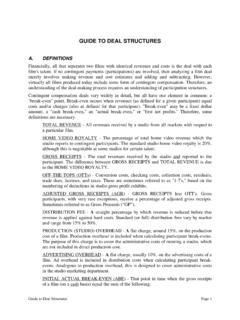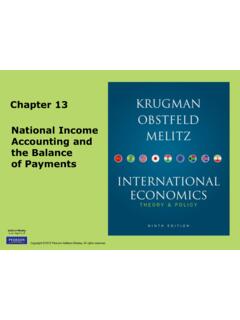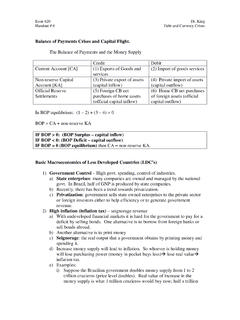Transcription of Notes on National Income and Balance of Payments Accounts
1 Copyright 1998 by Douglas H. Joines1 University of Sourthern CaliforniaGSBA 549 Marshall School of BusinessNotes on National Income and Balance of Payments AccountsThis handout briefly describes some features of the National Income and Product Accounts (NIPAs) andthe Balance of Payments Accounts (BPAs) and shows how the two sets of Accounts are related. A more detaileddescription of the NIPAs appears in the Mankiw Balance of Payments Accounts and the National Income and Product Accounts are separate sets ofaccounts that employ somewhat different accounting conventions. As the names suggest, the BPAs are primarilyconcerned with foreign transactions while the NIPAs are a more comprehensive set of Accounts dealing withboth domestic and foreign transactions.
2 Most of the foreign transactions recorded in the BPAs also appear in theNIPAs. Some items are given different names in the two Accounts so as to make it clear which set of Accounts (and thus which set of accounting conventions) the item is a part of. The differences in accounting conventionsare minor, so that the numbers reported in the BPAs are close to the corresponding entries in the NIPAs. In theexamples below, we will use the NIPAs as the source of data for both domestic and foreign transactions, but wewill refer to some foreign transactions by their BPA names because these names are more commonly used thanthose in the of Payments AccountsIn the BPAs, transactions that lead to Payments to foreign countries are debits and transactions that leadto receipts from foreign countries are credits.
3 Debits are recorded with a minus sign, and credits with a plussign. The major debit categories are: merchandise imports, service imports, Payments (profits, interest, rents)on foreign investments in the , gifts to foreigners, purchase of assets abroad by residents, and increasesin the government's international assets. The opposite transactions give rise to credits. (Gifts constitute anexception. Gifts received from foreigners are subtracted from gifts to foreigners, and net gifts to foreigners arerecorded as a debit entry. There is no corresponding credit.)Table 1 shows a hypothetical set of BPAs. (The table indicates that there is no official intervention.)
4 Official intervention will be defined later.) Rows 1 through 4 are the current account . Entries in these rows arepayments for currently produced goods and services and, as a consequence, also appear in the NIPAs. Rows 6and 7 are the capital account . Entries in these rows are Payments for exchanges of assets and, because they arenot Payments for currently produced goods and services, they do not appear directly in the first row of the table deals with merchandise imports and exports, and the sum of the debit andcredit entries in this row is called the merchandise trade Balance . If this sum is positive, exports exceed importsand the merchandise trade Balance shows a surplus.
5 Similar balances can be defined for the other rows of boththe current and capital Accounts , with the convention that a positive Balance corresponds to a surplus andindicates that receipts from foreigners exceed Payments to foreigners. The balances onTable 1 Hypothetical Balance of Payments Accounts (No Official Intervention)DebitsCreditsCol. 1 + Col. 2 Running Total of Col. 3(1)(2)(3)(4)Current imports 300 Merchandise exports200 Merchandise tradebalance 100 Merchandise tradebalance imports 60 Service exports50 Balance on services 10 Balance on goods andservices (trade Balance ) on foreigninvestment in 70 Receipts on abroad90 Balance on investmentincome (.)
6 Net factorincome from abroad)20 Balance on goods,services, and Income transfers 15 15 Current account in assets abroad 20 Change in privateforeign assets in capital account (net capital inflow)105(Official settlementsBOP) in assets0 Change in foreignofficial assets in capital accountbalance0 Balance of Payments02 individual lines can be combined to give successively more inclusive totals. For example, the sum of all debitand credit entries on lines 1 through 4 is called the current account the principles of double-entry bookkeeping, each debit entry must be matched by a credit. Thus, thesum of all debit and credit entries in all rows of the table (called the Balance of Payments ) must be zero.
7 A zerobalance of Payments requires that the current account Balance and the capital account Balance must be equal insize but opposite in sign. For example, a current account deficit of $100 billion implies a capital account surplusof $100 billion. A current account deficit means that the United States imports more currently produced goodsand services than it exports. A capital account surplus means that the United States sells more assets (locatedeither here or abroad) to foreigners than it buys from foreigners. If the United States is a net importer ofcurrently produced goods and services, it can pay for those goods and services only by being a net seller ofassets.
8 A capital account surplus is sometimes called a net capital inflow. A net inflow of currently producedgoods and services requires a net inflow of capital to pay for those goods and services. The capital accountdeficit is also sometimes called net foreign investment. A capital account deficit means that the United States isa net purchaser of assets from foreigners, so that the United States is increasing its net foreign asset position. Because the Balance of Payments must equal zero, net foreign investment must equal the current account . Infact, the term "current account " appears only in the BPAs, whereas the NIPAs use the term "net foreigninvestment.
9 " Apart from minor differences in accounting conventions, these two items are the , Exchange Rates, and Official InterventionSuppose that residents of a given country always demand payment in their own currency and do not holdforeign currencies. For example, when a merchant imports German appliances, she must pay the Germanexporter with Deutsche marks purchased on the foreign exchange market. Likewise, a German importer mustpurchase dollars to pay for goods exported from the United States to Germany. If the United States runs a tradebalance deficit with Germany, the demand for Deutsche marks (supply of dollars) by Americans exceeds thesupply of Deutsche marks (demand for dollars) by Germans.
10 The excess demand for marks (or excess supply ofdollars) tends to drive up the value of the markrelative to the than let the value of the dollar decline, the government can intervene in the foreignexchange market to support the dollar. If the government holds a supply of Deutsche marks, it can sellthese marks in exchange for dollars, thus equating the demand for and supply of marks on the foreign exchangemarket and preventing the mark from appreciating against the dollar. Deutsche marks held by the are a part of official assets, and sale of these marks would lead to a positive entry in Table 1,row 7, column 1. (The entry is positive because the sale of this asset leads to the receipt of dollars by the UnitedStates.)












